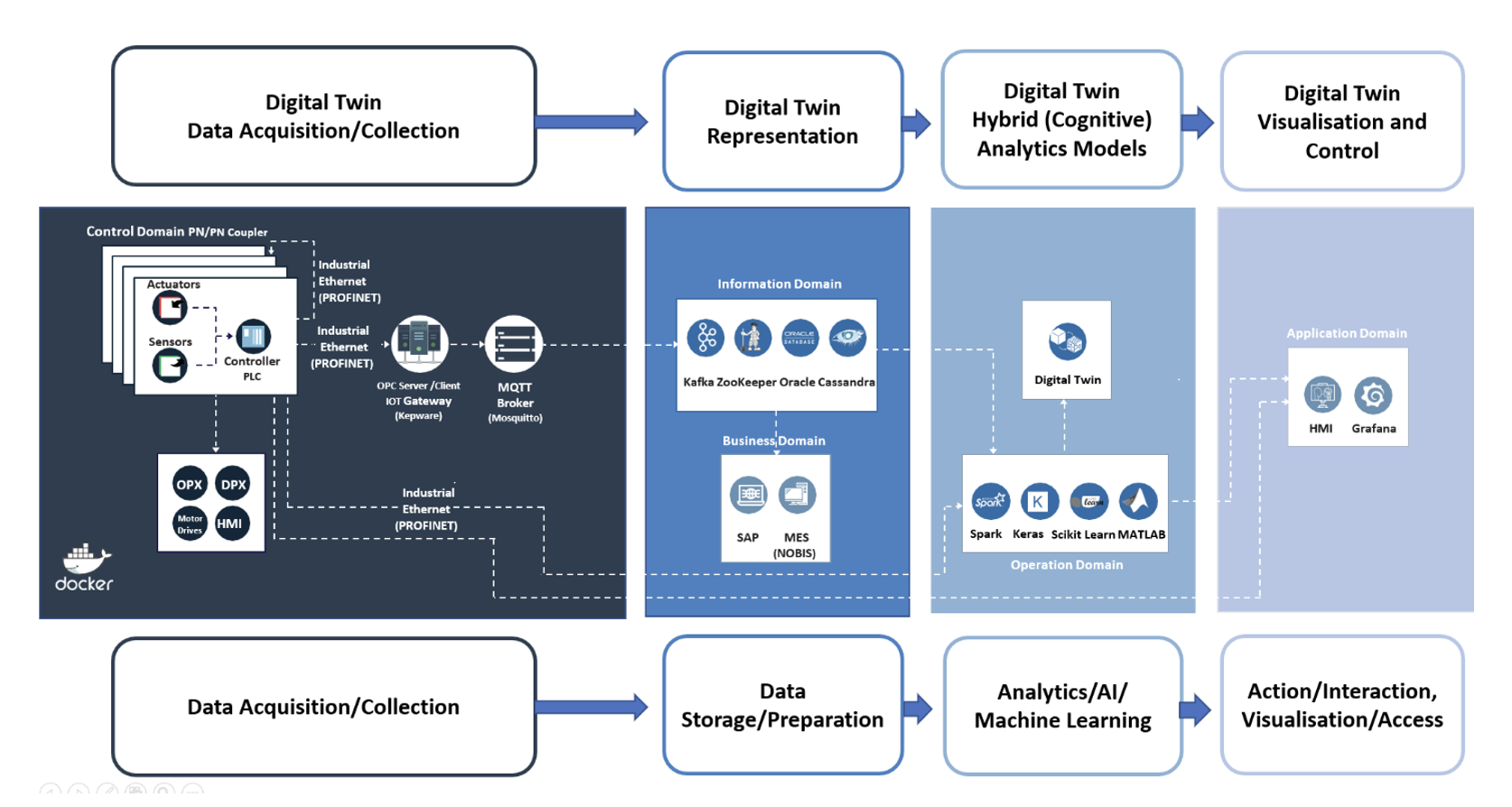This blog defines cognitive digital twins and offers a sample digital twin development pipeline architecture for cognitive digital twin development.
Cognitive Digital Twins
In parallel to the DTC’s digital twin definition, the widespread definition of digital twins is that they are digital representations of real-world assets, systems, or processes. The real-world elements, i.e., assets/ systems/ processes, have cognitive abilities of various types and levels. For high-fidelity digital twins, digital twins also require cognitive characteristics.
Cognition is a form of computation that views the mind as a machine. In the context of digital twins, cognition is a computation form that reflects and simulates assets, machines, and processes using AI in real-time. To develop cognitive digital twins, you must compute the status, behaviors, and relevant interrelated models of the real-world elements in digital environments.
With the ability to learn at run-time, digital twins become cognitive digital twins with artificial intelligence (AI) functions and cognitive capabilities. As a result, organizations can now use new applications for digital twins that have been infeasible in the past. Cognitive digital twins are beneficial because they are self-learning and can foresee the future.
A hybrid digital twin integrates data from various sources like sensors and databases with digital twin models. It is an extension of a hybrid digital twin that incorporates cognitive features to enable the sensing of complex reasoning about dynamic process optimization strategies.
Cognitive digital twins that are self-learning may foresee the future and make decisions based on the models, actual data (both batch and stream), and estimated data. In cases of lack of data, synthetic data are created based on high-fidelity models, reflecting the actual system.
A Pipeline to Generate Cognitive Digital Twins
The first phase of cognitive digital twin generation requires an IoT platform so data organizations can collect data from real-world assets, systems, processes, sensors, and actuators. Organizations will connect data sources through an IoT platform. They transmit, process, and store data in the second phase to fulfill the requirements. Once the data is being retrieved both in streams and stored in permanent stores, data analytics is performed, followed by ML/DL model generations. Finally, in the UX part, the cognitive digital twin is presented to the users in different forms, including 3D, XR, GIS, etc.
Figure 1-Cognitive Digital Twin Development Pipeline Sample [Unal et al. 2022]
Summary
The real-world elements of digital twins, i.e., assets/ systems/ processes, have cognitive abilities of various types and levels. For high-fidelity digital twins, digital twins also require cognitive characteristics.
This blog defines cognitive digital twins and provides a sample digital twin development pipeline architecture for cognitive digital twin development.
Case Study: A Cognitive Digital Twin in a Steel Pipe Manufacturing Factory
A cognitive digital twin for a spirally welded steel pipe manufacturing machine can detect anomalies, provide predictive maintenance, or estimate the remaining useful life of the SWP machine components.
Problem: steel pipe manufacturing occurs seven days a week, 24 hours a day. When a single unexpected defect may stop the whole production unwantedly, these unplanned stops result in high costs for maintenance and production. Plus, due to these stops, delays in meeting customers’ orders may happen. Without a system that continuously enables real-time monitoring of manufacturing and predicting anomalies, there is no ability to prevent unpredictable downtimes.
As a result, manufacturing happens at low levels of production efficiency. It is highly costly to maintain the system. The energy consumption and the associated carbon footprint are high, and organizations must reduce them to lower levels for competitiveness and revenue reasons.
Solution: Around 60 different new sensors have been installed on the machine components, summing up to a total of 125 sensors with preinstalled ones. The organization designed and developed a sensor network using an IIoT Platform, and data has been acquired, transmitted, processed, and stored. They used the platform-independent solution to detect anomalies in real-time. Big data accumulated has been reported, analyzed, and visualized without delay.
A real-time online monitoring system enables users of different levels (maintenance operators and managers) to make better and informed decisions. They used machine learning and deep learning models to train data-based artificial intelligent models. They also used trained models on stream data for anomaly detection and predictive maintenance. 3D models of the machine components display to the users as part of the cognitive digital twin visualization functionalities.
Benefits: Below, find a list of benefits at Turkey’s second largest steel pipe manufacturing company.
- 10% decrease in energy consumption in spirally welded steel pipe manufacturing
- The reduced carbon footprint for a sustainable world and life
- Detection of machine failures in advance they occur
- Enabled predictive maintenance
- Decrease in SWP maintenance costs
- Increased Overall Equipment Effectiveness
- Increased production efficiency due to decreased unpredictable downtimes
- Decreased machine downtime due to unplanned stops
- High level of accuracy of machine learning models in measuring Remaining Useful Life
About the Author
By Dr. Perin Ünal
Managing Partner, Teknopar


